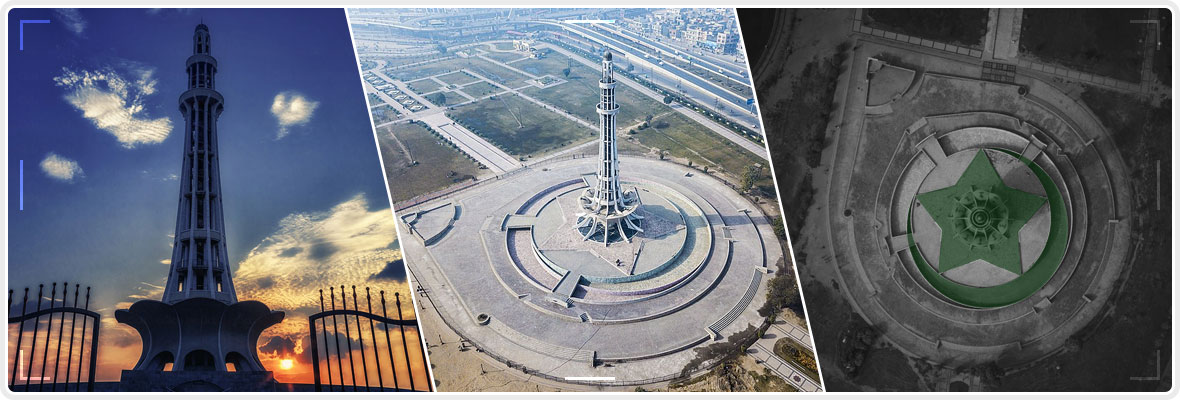
Minar-e-Pakistan is Hidden Symbol Of Pakistan Revealed
Table of Contents
Aerial photographs of the much-loved Minar-e-Pakistan reveal some magnificent views of Lahore itself.
Photos taken from a specific angle show that Minar Pakistan’s architects used elegant geometric patterns and art to incorporate national symbols into iconic monuments.
Facebook user Tahir Mahmoud Chaudhry shared a post describing how he first noticed the little-known feeling of the monument.
Chaudhry’s image shows how the memorial looks like a flower from above, in a star surrounded by two half-moon moons, one white and one green.
https://www.facebook.com/photo.php?fbid=10158193669339669&set=a.92838224668&type=3
The monumental architect Nasreddin Murat Khan, a monumental immigrant, is a Russian immigrant who makes Pakistan his hometown. According to a letter (provided by Google) “Illeri H N Murat Khan and Associates” he wrote on the header of his studio, he hoped to create a “symbol that symbolizes the power of Pakistan”.
The search engine giant has partnered with the Citizens Archive Pakistan (CAP) to document how the monument was built. The architect was also involved in the fact that he wanted to create a memorial exhibition and a towering tower-like structure to form a “divisible whole.”
Khan created a crescent-shaped garden surrounding the temple. Satellites represent half of eastern and western Pakistan and are embracing.
The Russian-born architect wanted to create two stair steps, with each crescent-shaped staircase climbing up the stairs. He did this to symbolize the spiritual contribution to the two wings of the country, just like the expected bone leader.
The job can be seen in this photo, which was shared by a Twitter account called “Discover Pakistan” and added to Hanan Khaleeq.
مینار پاکستان
Stunning! Aerial view of Minar e Pakistan, #Lahore, #Pakistan
Credits: HananKhaleeq#BeautifuPakistan #Travel pic.twitter.com/gMtoPRyYdw
— Discover Pakistan 🇵🇰 | پاکستان (@PakistanNature) August 12, 2018
Khan didn’t want the monument to appear as a tomb or mosque, because he wanted to emphasize the beauty of the Mughal dynasty decoration. The architect also disagrees with conventional wisdom, as he believes that “Pakistan is a bold and brand new experience in the Islamic world.”
In an interview, his daughter Meral Murat Khan mentioned that his father had invented three models of the Ten Year Plan. “The model that was really built was the third model,” Meral shared.
In an interview with the Pakistan Citizens Archive, he also talked about his father’s original idea behind Minar.
Melar, who accompanied his father many times, recalled: “His idea of Minar is indeed to reach some kind of ending. The key is because Pakistan’s wishes continue indefinitely, it will only disappear.” When the memorial was completed.
He also emphasized that the path produced by mining is dedicated to making it look like petals. Khan didn’t want to “cover” the monument because he thought it would mean “slowing” his growth.
Meral shared that Khan’s original idea could not be implemented because the committee overseeing the committee ignored it. She said that her father had implemented the project to “advance this country to his hometown”.
Khan also did not charge the government for the services he provided for the project.
The monument is probably the most famous site created to commemorate Pakistan’s decision, marking the first step in establishing Pakistan’s history. Construction began in 1960 and completed in October 1968 for 8 years. Considered a fusion of Islamic and Mughal cultures, this national monument includes three steps, symbolizing the challenges and three stages of success for Pakistan’s independence journey.
The first step is made of stone from Taxila, the second step is hammered stone, the third step is carved stone, and the fourth and final step is made of white marble. The text of the Pakistani decision read aloud the floral inscription at the bottom of the beacon, and the case strengthened between Iqbal’s dreams and Jinnah’s struggle.
There are also famous quotes from the historical sermons of the great leaders and the turnout of the temple. To this day, Minar e Pakistan is still the political terrain that politicians and revolutionaries aspire to achieve.
Since 2017, Saba Ghani has been serving as the talented and dedicated chief content writer for Pakistan Tour and Travel & EMHI Solutions. With her exceptional writing skills and in-depth knowledge of the travel industry, she has been instrumental in crafting engaging and informative content that captivates the audience. You can catch her at [email protected] or Twitter
Best Pakistan Tour Packages from Islamabad & Karachi